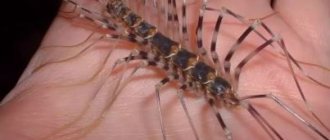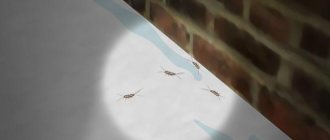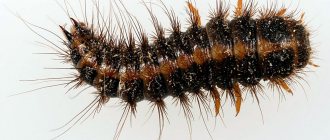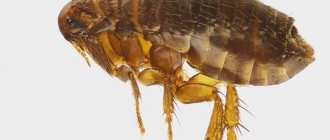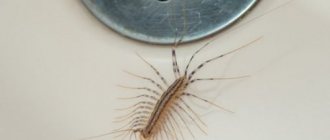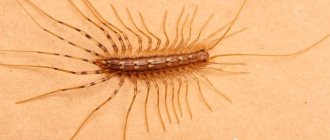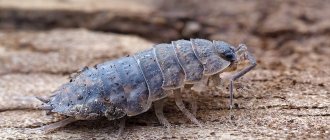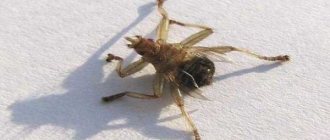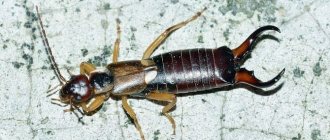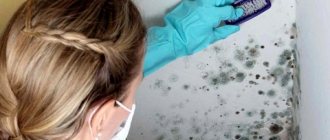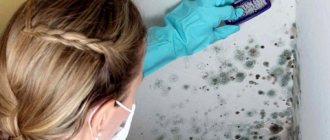Throughout life, the human home attracts many insects, since they can hide in it, spend the winter and find something to eat. At the same time, there is the appearance of many, sometimes dangerous insects, the proximity of which does not bode well. As for the centipede, it is the most harmless creature that can be found in a person’s home. Moreover, such a neighborhood can bring a positive effect, although few people know about it.
Therefore, first of all, the centipede scares apartment residents with its not very attractive appearance: the body is long and sinuous with many legs. Fear arises because practically no one knows what kind of insect this is and what to do with it. This article explains what this insect is and how to deal with it.
What is it like?
The common centipede got its name for a reason. In her case, everything is obvious - many legs do not go unnoticed. Thanks to this, the arthropod runs very fast. In 1 second she covers up to 40 cm. This allows her to quickly hide when danger appears.
If you carefully examine the centipede, you can find small hairs all over its body, and long antennae on its head. There are also stripes running along the body that extend to the paws. Some people associate the centipede with a scary beetle with a flexible, curved body.
The centipede is an ancient and harmless animal
In fact, it is an animal, not an insect. An arthropod that also has other names:
- centipede;
- flycatcher;
- scolopendra.
And she actually has 30 legs, all of which are capable of completely regenerating if injured or lost. There is also a respiratory organ.
Her body consists of segments that allow her to be nimble and agile. The forelimbs have claws for capturing and holding prey, and the remaining legs have sharp spines, with which it easily moves across any surface. Having grabbed onto the victim, the centipede bites it and injects it with paralyzing poison, and then eats it.
But meeting a person for the latter does not pose any particular danger. Except that psychologically her frightening appearance is impressive. Scolopendras come in different sizes - from 2 to 15 cm, but large individuals can hardly be found in human habitats, except in the tropics, and in Russia species larger than 5 cm have not been found.
Flycatchers are predators, and in nature their role is extremely important in maintaining the natural balance and balance of the number of organisms. The name of this living creature speaks for itself - they catch flies, as well as:
- cockroaches and worms;
- midges and moths;
- wood bugs, spiders;
- larvae of other insects.
Without centipedes, it would be more difficult for humans to fight numerous pests of gardens, vegetable gardens, and nature reserves. In total, there are several thousand species of flycatchers in nature, and they are the oldest inhabitants on Earth.
Why is it dangerous?
With the appearance of unusual neighbors, people are interested in why centipedes are dangerous. Apart from its frightening appearance, the common flycatcher is absolutely safe for households or their pets. In addition, the centipede prefers to hunt at night, so many people are not even aware of its existence.
If you try to pick up the centipede with your hands, you will likely experience irritation on the skin. This is due to the fact that the flycatcher’s venom transfers to the skin from the paws. Like insect bites, this can cause some discomfort to a person.
But it is easy to get rid of it by placing the limb under a stream of cold water.
Preventive measures
After getting rid of centipedes, owners need to use prevention methods. Arthropods will not be able to enter the apartment if these conditions are met:
- maintain order in the local area;
- promptly clear the garden of fallen leaves and the vegetable garden of dry grass;
- clean and remove construction waste from the yard;
- remove climbing plants from external walls;
- carefully seal cracks in walls, floors, and window frames;
- strengthen small mesh on ventilation ducts;
- ventilate wet areas well;
- quickly eliminate leaks and condensation;
- fight insects that have entered your home.
It is easy to defeat this creature if you carry out preventive measures in a timely manner.
What does it look like
Almost everyone knows what centipedes look like. The external structure of centipedes is simple. The body is divided into a separate head and torso, consisting of a varying number of segments.
The head is a fusion of the acron and 4 segments of the body . It also has a pair of antennae and 3 pairs of limbs. In labiopods, the head limbs resemble those found in insects.
The body of an adult centipede reaches a length of up to 60 mm. Basic color: from gray with a yellowish tint to bright brown. 3 purple or blue parallel stripes are visualized on the back.
How many legs
Arthropodologists can tell you how many legs centipedes have. They argue that the number of legs changes dynamically as the flycatcher grows and ages. And their number directly depends on the number of body segments. At first, the newborn centipede has 1 to 4 segments with 4 pairs of striped limbs.
As the body grows, new legs appear . In an adult, there are a maximum of 15 pairs. In this case, the outermost pair of limbs is longer than the others and more closely resembles whip-like antennae.
How to get rid
Many people are concerned about how to get rid of centipedes in a private home, since they find them on their territory quite often. But there are also those who are interested in how to get rid of centipedes in an apartment.
Arthropodologists argue that it is not necessary to immediately resort to aggressive methods. To begin with, it is advisable to use simple, non-toxic methods.
Folk remedies
When flycatchers appear in an apartment, experienced housewives will tell you what to do. They tried folk remedies from personal experience.
These methods are popular:
- Keeping clean and dry. Centipedes are attracted to moisture. If the room is warm and damp, then arthropods will willingly live there. To remove them, try to wipe dry all wet places in the apartment or house. They also carry out regular cleaning and get rid of fungal growths on the walls.
- Freezing of living space. Family members leave the house or apartment and leave the room without heating for 2-3 days in winter. During this time, not only centipedes die, but also other pests. But since many residential premises use a central heating system, not everyone will be able to use this method of control.
- Use of boric acid. This inexpensive pharmaceutical drug gets rid of insects and rodents. Arthropods such as the centipede are also afraid of it. Fragments of boric acid, when they come into contact with the body of the flytrap or inside, cause a strong burning sensation, causing death.
Experienced housewives also recommend installing fine-mesh grilles on all ventilation openings, which must be cleaned regularly. In addition, it is advisable to make a classic cosmetic repair when peeling wallpaper, cracks in the plaster or fallen tiles appear.
Mechanical methods
Centipedes are interesting arthropods. Some claim that they have a good memory and are able to compare certain events. If you catch several centipedes and then release them on the street far from the house, then the remaining arthropods will also not claim this living space.
But not everyone is so humane towards such creatures, so most often they get rid of them using a fly swatter or slippers.
Chemicals
When resorting to the help of chemicals, it is important to think carefully about how to poison centipedes, since not all the usual poisons that kill harmful insects act on them.
Modern methods of combating centipedes include the following::
- Glue traps. Some try to catch centipedes using this product, which has proven itself in the fight against cockroaches or ants. But doing this is pointless, because even if the centipede falls into a trap and sticks with several legs, it will lose them without regret. This will not prevent her from running, and the damaged limbs will grow back.
- Medilis-Ziper. This toxic agent has proven itself well in the fight against arthropods. It is sprayed using a spray bottle in those places where centipedes run most often. This product is good because it does not harm pets.
- Global Original. The product is available in the form of a paste. It has a toxic effect on many pests. The product has an unpleasant odor, but it is faint, so the paste is used in apartments with pets. The insecticide is applied in a thin layer along baseboards and where centipedes often appear.
If you decide to fight centipedes with toxic drugs, you should take care of your personal safety by using gloves and a protective mask. And before returning to your apartment or house, they should be thoroughly ventilated.
Ways to combat centipedes in an apartment
Not all standard methods of controlling insects in an apartment are suitable for killing centipedes. For example, sticky traps recommended by many turn out to be ineffective and even useless. The fact is that even if they get stuck, flycatchers run away without several of their legs being torn off. They then quickly grow new limbs. These arthropods also cannot be frightened by poisoned baits. They feed exclusively on insects, and bait in the form of flies and cockroaches has not yet been invented.
Universal remedies for domestic insects will help in the fight against centipedes: sprays, aerosols, fumigators
The “highlight of the program” for getting rid of flycatchers is the extermination of insect pests. Once the centipede loses its constant source of food, it will be forced to leave the house.
It must be remembered that flycatchers are found in small numbers in residential areas. They do not breed in unusual environments. Therefore, it is enough to simply catch them and release them into the street. If you are still inclined to take radical measures, then you can kill the insect in any common way. Among chemical preparations, sprays are more suitable:
- Starex;
- Medilis-cyper;
- Henkel Combat;
- Raid.
You can also use products that do not require spraying:
- Globol Origina pasta;
- Lambda zone granules;
- aquafumigator Raptor.
Lifestyle
A centipede is an arthropod that has a unique lifestyle, habitat and food preferences.
Where does it live?
The common flycatcher is found where the climate is temperate. Millipedes can live in Europe, the Middle East and northern Africa. They prefer to hide under stones, fallen leaves or plant debris. The house centipede primarily hunts at night.
Common flycatchers flock to people's houses and apartments with the arrival of cold weather.
Choose dark and damp places to live:
- basements;
- bathrooms;
- restrooms.
Despite their appearance, centipedes are not the most harmful living creatures trying to live near humans.
Video
Flycatcher eating
Woodlice
Wood lice often appear in the bathroom and toilet. They are mistakenly called insects, although they belong to the class of crustaceans. It’s just that the relatives of crayfish have adapted to life on land, although they look for places with high humidity. They are easy to distinguish by their appearance - they have an oval body, convex at the top, divided into segments and covered with hard plates. The body may be light, with a slight yellowish tint, or dark brown or gray. Another distinctive feature is their behavior: in case of danger, woodlice curl up into a ball.
These insects are frequent guests in the bathroom. They are called wood lice
Woodlice feed on rotting organic matter. Spoiled vegetables, fruits, herbs are from the diet. Fungi that develop in damp areas are also suitable for them to feed on. Therefore, in addition to the bath and toilet, they can be found in the kitchen, and brought in with spoiled food. It also finds them in rooms if apartment dwellers or pets have a habit of leaving food under beds or sofas.
You can get rid of wood lice in the bathroom and toilet only by thoroughly drying the room, removing all possible sources of food. In addition to the measures described above (prevent water from getting on the floor, walls, improve ventilation), it is necessary to carry out thorough cleaning and disinfection. You can use a solution of bleach, Domestos, and other similar products for these purposes.
